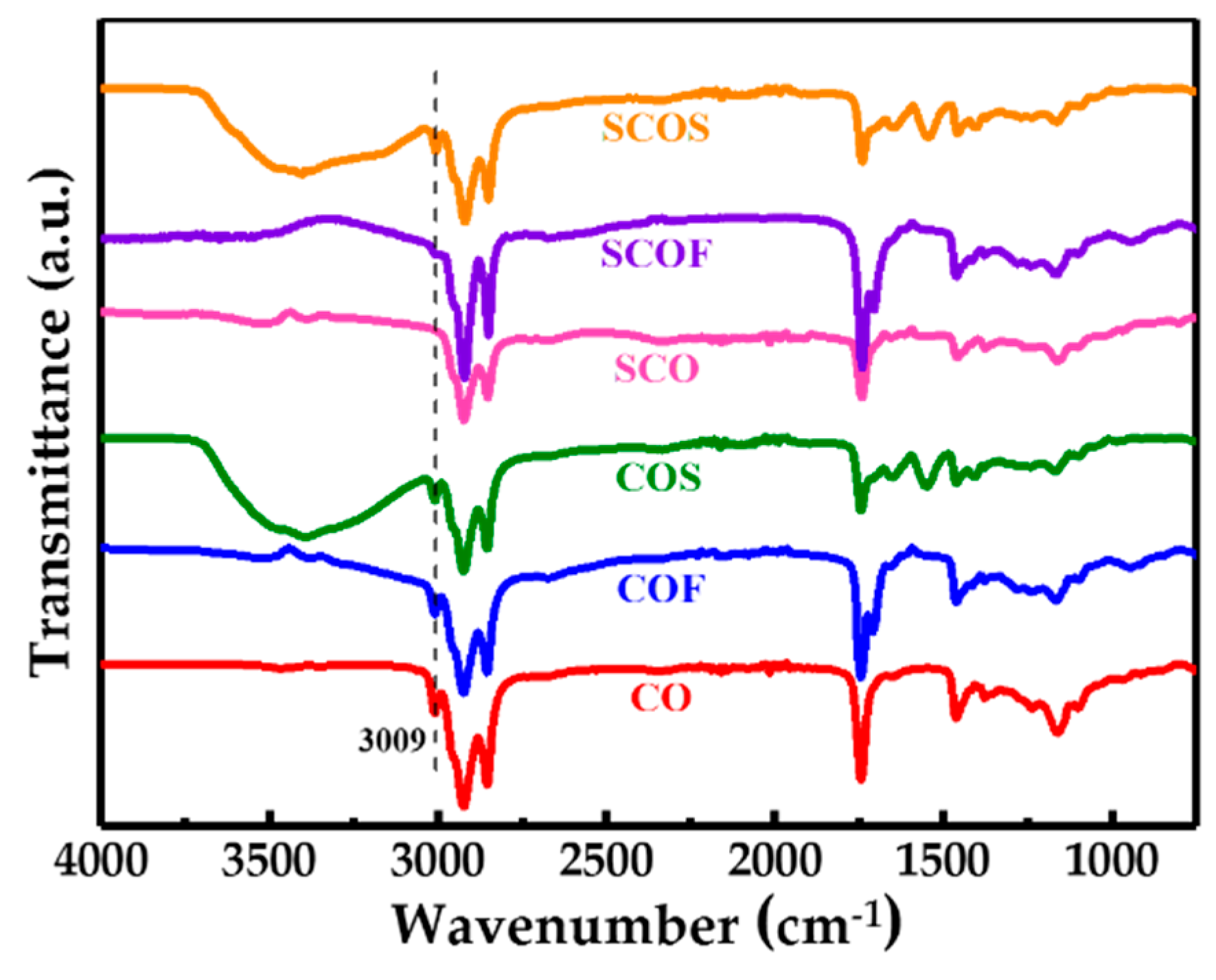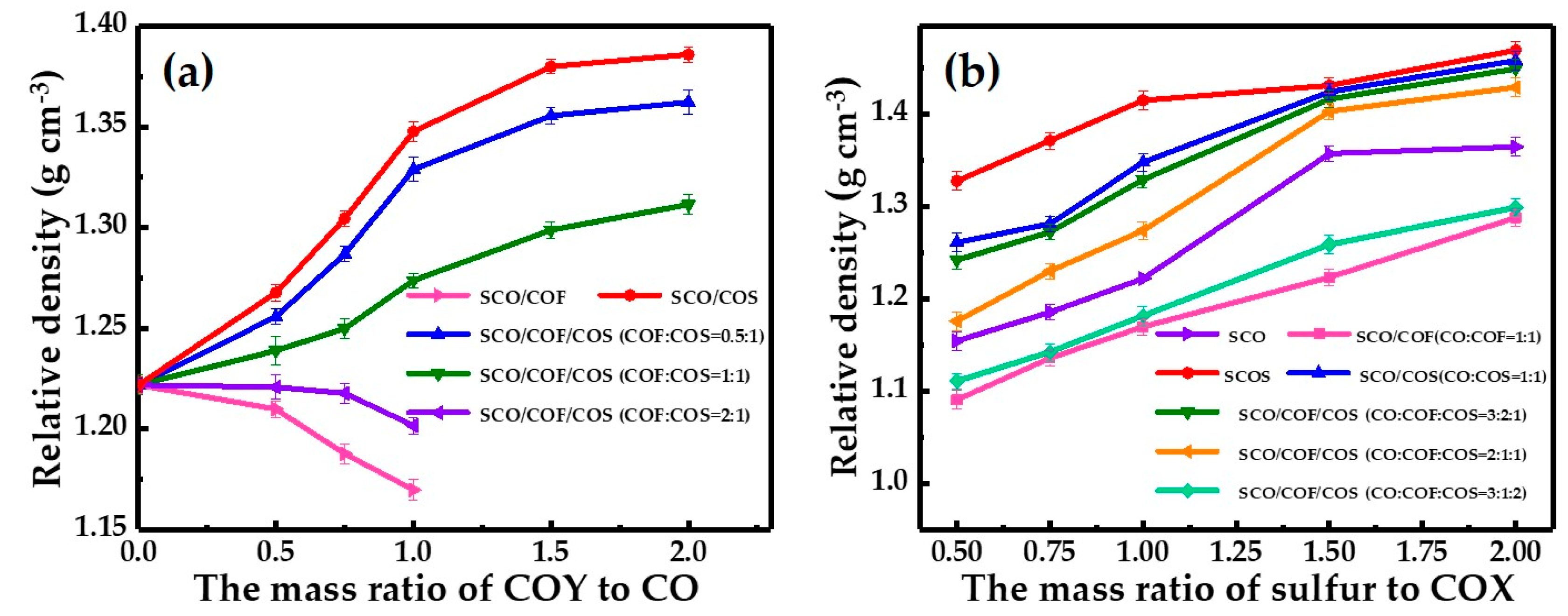Design and Preparation of Polysulfide Flexible Polymers Based on Cottonseed Oil and Its Derivatives
Abstract
1. Introduction
2. Materials and Methods
2.1. Materials
2.2. Preparation of Polysulfide-Derived Polymers
2.3. Characterization
2.4. Self-Healing Experiments
3. Results and Discussion
3.1. Synthesis and Characterization
3.2. Density Analysis
3.3. Mechanical Strength Analysis
3.4. Reprocessability and Recyclability
4. Conclusions
Author Contributions
Funding
Conflicts of Interest
References
- Trautner, S.; Lackner, J.; Spendelhofer, W.; Huber, N.; Pedarnig, J.D. Quantification of the Vulcanizing System of Rubber in Industrial Tire Rubber Production by Laser-Induced Breakdown Spectroscopy (LIBS). Anal. Chem. 2019, 91, 5200–5206. [Google Scholar] [CrossRef]
- Sun, L.; Xue, Y.; Peng, C.; Xu, C.; Shi, J. Does sulfur fertilizer influence Cu migration and transformation in colloids of soil pore water from the rice (Oryza sativa L.) rhizosphere? Environ. Pollut. 2018, 243, 1119–1125. [Google Scholar] [CrossRef]
- Chaudhuri, R.G.; Paria, S. Synthesis of sulfur nanoparticles in aqueous surfactant solutions. J. Colloid Interface Sci. 2010, 343, 439–446. [Google Scholar] [CrossRef]
- Griebel, J.J.; Glass, R.S.; Char, K.; Pyun, J. Polymerizations with elemental sulfur: A novel route to high sulfur content polymers for sustainability, energy and defense. Prog. Polym. Sci. 2016, 58, 90–125. [Google Scholar] [CrossRef]
- Deng, Z.; Hoefling, A.; Théato, P.; Lienkamp, K. Surface Properties and Antimicrobial Activity of Poly (sulfur-co-1,3-diisopropenylbenzene) Copolymers. Macromol. Chem. Phys. 2018, 219, 1700497. [Google Scholar] [CrossRef]
- Worthington, M.J.H.; Kucera, R.L.; Chalker, J.M. Green chemistry and polymers made from sulfur. Green Chem. 2017, 19, 2748–2761. [Google Scholar] [CrossRef]
- Chung, W.J.; Griebel, J.J.; Kim, E.T.; Yoon, H.; Simmonds, A.G.; Ji, H.J.; Dirlam, P.T.; Glass, R.S.; Wie, J.J.; Nguyen, N.A.; et al. The use of elemental sulfur as an alternative feedstock for polymeric materials. Nat. Chem. 2013, 5, 518–524. [Google Scholar] [CrossRef]
- Sun, Z.; Xiao, M.; Wang, S.; Han, D.; Song, S.; Chen, G.; Meng, Y. Sulfur-rich polymeric materials with semi-interpenetrating network structure as a novel lithium–sulfur cathode. J. Mater. Chem. A 2014, 2, 9280. [Google Scholar] [CrossRef]
- Lin, H.K.; Liu, Y.L. Sulfur Radical Transfer and Coupling Reaction to Benzoxazine Groups: A New Reaction Route for Preparation of Polymeric Materials Using Elemental Sulfur as a Feedstock. Macromol. Rapid Commun. 2018, 39, 1700832. [Google Scholar] [CrossRef]
- Gutarowska, B.; Kotynia, R.; Bielinski, D.; Anyszka, R.; Wreczycki, J.; Piotrowska, M.; Kozirog, A.; Berlowska, J.; Dziugan, P. New Sulfur Organic Polymer-Concrete Composites Containing Waste Materials: Mechanical Characteristics and Resistance to Biocorrosion. Materials 2019, 12, 2602. [Google Scholar] [CrossRef]
- Griebel, J.J.; Namnabat, S.; Kim, E.T.; Himmelhuber, R.; Moronta, D.H.; Chung, W.J.; Simmonds, A.G.; Kim, K.J.; van der Laan, J.; Nguyen, N.A.; et al. New infrared transmitting material via inverse vulcanization of elemental sulfur to prepare high refractive index polymers. Adv. Mater. 2014, 26, 3014–3018. [Google Scholar] [CrossRef] [PubMed]
- Dirlam, P.T.; Simmonds, A.G.; Kleine, T.S.; Nguyen, N.A.; Anderson, L.E.; Klever, A.O.; Florian, A.; Costanzo, P.J.; Theato, P.; Mackay, M.E.; et al. Inverse vulcanization of elemental sulfur with 1,4-diphenylbutadiyne for cathode materials in Li–S batteries. RSC Adv. 2015, 5, 24718–24722. [Google Scholar] [CrossRef]
- Griebel, J.J.; Nguyen, N.A.; Namnabat, S.; Anderson, L.E.; Glass, R.S.; Norwood, R.A.; Mackay, M.E.; Char, K.; Pyun, J. Dynamic Covalent Polymers via Inverse Vulcanization of Elemental Sulfur for Healable Infrared Optical Materials. ACS Macro Lett. 2015, 4, 862–866. [Google Scholar] [CrossRef]
- Hasell, T.; Parker, D.J.; Jones, H.A.; McAllister, T.; Howdle, S.M. Porous inverse vulcanised polymers for mercury capture. Chem. Commun. 2016, 52, 5383–5386. [Google Scholar] [CrossRef] [PubMed]
- Hoefling, A.; Lee, Y.J.; Theato, P. Sulfur-Based Polymer Composites from Vegetable Oils and Elemental Sulfur: A Sustainable Active Material for Li-S Batteries. Macromol. Chem. Phys. 2017, 218, 1600303. [Google Scholar] [CrossRef]
- Maraveas, C. Production of Sustainable and Biodegradable Polymers from Agricultural Waste. Polymers 2020, 12, 1127. [Google Scholar] [CrossRef] [PubMed]
- Kim, D.; Kim, I.C.; Kyun, Y.N.; Myung, S. Novel bio-based polymer membranes fabricated from isosorbide-incorporated poly(arylene ether)s for water treatment. Eur. Polym. J. 2020, 136, 109931. [Google Scholar] [CrossRef]
- Jiao, H.W.; Jin, C.H. Role of Bio-Based Polymers on Improving Turbulent Flow Characteristics: Materials and Application. Polymers 2017, 9, 209. [Google Scholar] [CrossRef]
- Tondi, G.; Schnabel, T. Bio-Based Polymers for Engineered Green Materials. Polymers 2020, 12, 775. [Google Scholar] [CrossRef]
- Worthington, M.J.H.; Kucera, R.L.; Albuquerque, I.S.; Gibson, C.T.; Sibley, A.; Slattery, A.D.; Campbell, J.A.; Alboaiji, S.F.K.; Muller, K.A.; Young, J.; et al. Laying Waste to Mercury: Inexpensive Sorbents Made from Sulfur and Recycled Cooking Oils. Chemistry 2017, 23, 16219–16230. [Google Scholar] [CrossRef]
- Moawia, R.M.; Nasef, M.M.; Mohamed, N.H.; Ripin, A.; Zakeri, M. Biopolymer catalyst for biodiesel production by functionalisation of radiation grafted flax fibres with diethylamine under optimised conditions. Radiat. Phys. Chem. 2019, 164, 108375. [Google Scholar] [CrossRef]
- Malhotra, R.; Ali, A. Lithium-doped ceria supported SBA−15 as mesoporous solid reusable and heterogeneous catalyst for biodiesel production via simultaneous esterification and transesterification of waste cottonseed oil. Renew. Energy 2018, 119, 32–44. [Google Scholar] [CrossRef]
- Nantha, G.K.; Ashok, B.; Senthil, K.K.; Thundil, K.R.R.; Denis, A.S.; Varatharajan, V.; Anand, V. Performance analysis and emissions profile of cottonseed oil biodiesel–ethanol blends in a CI engine. Biofuels 2017, 9, 711–718. [Google Scholar] [CrossRef]
- Shrimal, P.; Sanklecha, H.; Patil, P.; Mujumdar, A.; Naik, J. Biodiesel Production in Tubular Microreactor: Optimization by Response Surface Methodology. Arab. J. Sci. Eng. 2018, 43, 6133–6141. [Google Scholar] [CrossRef]
- Chen, Y.; Yasin, A.; Zhang, Y.; Zan, X.; Liu, Y.; Zhang, L. Preparation and Modification of Biomass-Based Functional Rubbers for Removing Mercury(II) from Aqueous Solution. Materials 2020, 13, 632. [Google Scholar] [CrossRef]
- Liang, H.C.; Lu, C.K.; Chang, J.R.; Lee, M.T. Use of waste rubber as concrete additive. Waste Manag. Res. 2007, 25, 68–76. [Google Scholar] [CrossRef]
- Grinys, A.; Sivilevičius, H.; Daukšys, M. Tyre Rubber Additive Effect on Concrete Mixture Strength. J. Civil. Eng. Manag. 2012, 18, 393–401. [Google Scholar] [CrossRef]
- Zarei, M.; Rahmani, Z.; Zahedi, M.; Nasrollahi, M. Technical, Economic, and Environmental Investigation of the Effects of Rubber Powder Additive on Asphalt Mixtures. J. Transp. Eng. Part. B Pavements 2020, 146, 04019039. [Google Scholar] [CrossRef]
- Wulandari, P.S.; Tjandra, D. Use of Crumb Rubber as an Additive in Asphalt Concrete Mixture. Procedia Eng. 2017, 171, 1384–1389. [Google Scholar] [CrossRef]
- Wang, W.; Song, Q.; Liu, Q.; Zheng, H.; Li, C.; Yan, Y.; Zhang, Q. A Novel Reprocessable and Recyclable Acrylonitrile-Butadiene Rubber Based on Dynamic Oxime-Carbamate Bond. Macromol. Rapid Commun. 2019, 40, 1800733. [Google Scholar] [CrossRef]
- Zhang, Q.; Shi, C.Y.; Qu, D.H.; Long, Y.T.; Feringa, B.L.; Tian, H. Exploring a naturally tailored small molecule for stretchable, self-healing, and adhesive supramolecular polymers. Sci. Adv. 2018, 4, 8192. [Google Scholar] [CrossRef]






| Samples | Components | Mass Ratio of Reactants | Temperature (°C) | Time 1 (min) |
|---|---|---|---|---|
| SCO | S:CO | 0.5, 0.75, 1, 1.5, 2:1 | 150 | 25–30 |
| SCOF | S:COF | 0.5, 0.75, 1, 1.5, 2:1 | 150 | 25–30 |
| SCOS | S:COS | 0.5, 0.75, 1, 1.5, 2:1 | 150 | 20–25 |
| SCO/COF | CO:COF | 1:0.5, 0.75, 1.0 | 150 | 15–20 |
| S:CO/COF | 0.5, 0.75, 1, 1.5, 2:1 | |||
| SCO/COS | CO:COS | 1:0.5, 0.75, 1, 1.5, 2 | 150 | 15–20 |
| S:CO/COS | 0.5, 0.75, 1, 1.5, 2:1 | |||
| SCO/COF/COS | COF:COS | 0.5, 1, 2:1 | 150 | 15–20 |
| CO:COF/COS | 1:0.5, 0.75, 1, 1.5, 2 | |||
| S:CO/COF/COS | 0.5, 0.75, 1, 1.5, 2:1 |
| Samples | Peak (cm−1) | Relative Intensity (%) |
|---|---|---|
| CO | 3009 | 33.82 |
| COF | 3009 | 45.22 |
| COS | 3009 | 47.81 |
| SCO | 3009 | 2.09 |
| SCOF | 3009 | 3.98 |
| SCOS | 3009 | 47.08 |
| Fatty Acid Methyl Ester | Relative Content (%) |
|---|---|
| Methyl tetradecanoate | 0.31 |
| Methyl palmitate | 16.70 |
| Methyl stearate | 1.45 |
| Methyl oleate | 15.25 |
| Methyl linoleate | 60.61 |
© 2020 by the authors. Licensee MDPI, Basel, Switzerland. This article is an open access article distributed under the terms and conditions of the Creative Commons Attribution (CC BY) license (http://creativecommons.org/licenses/by/4.0/).
Share and Cite
Chen, Y.; Liu, Y.; Chen, Y.; Zhang, Y.; Zan, X. Design and Preparation of Polysulfide Flexible Polymers Based on Cottonseed Oil and Its Derivatives. Polymers 2020, 12, 1858. https://doi.org/10.3390/polym12091858
Chen Y, Liu Y, Chen Y, Zhang Y, Zan X. Design and Preparation of Polysulfide Flexible Polymers Based on Cottonseed Oil and Its Derivatives. Polymers. 2020; 12(9):1858. https://doi.org/10.3390/polym12091858
Chicago/Turabian StyleChen, Yurong, Yanxia Liu, Yidan Chen, Yagang Zhang, and Xingjie Zan. 2020. "Design and Preparation of Polysulfide Flexible Polymers Based on Cottonseed Oil and Its Derivatives" Polymers 12, no. 9: 1858. https://doi.org/10.3390/polym12091858
APA StyleChen, Y., Liu, Y., Chen, Y., Zhang, Y., & Zan, X. (2020). Design and Preparation of Polysulfide Flexible Polymers Based on Cottonseed Oil and Its Derivatives. Polymers, 12(9), 1858. https://doi.org/10.3390/polym12091858







